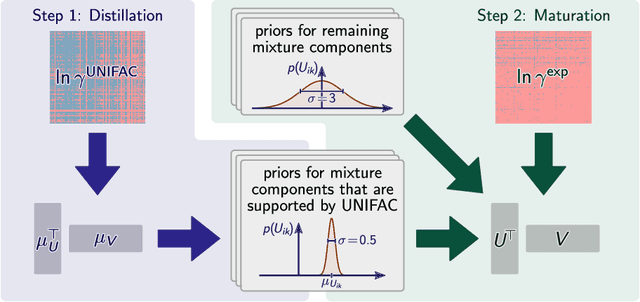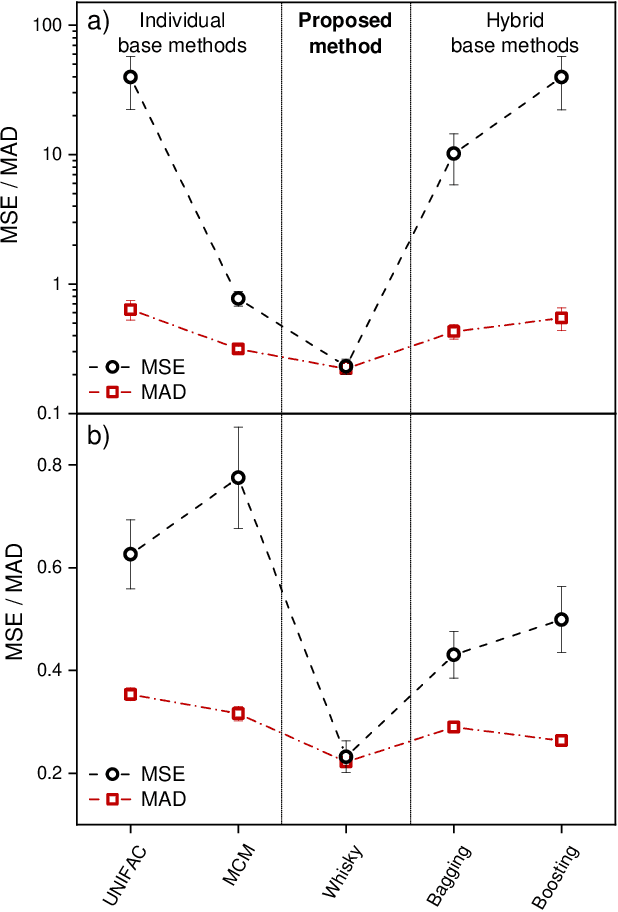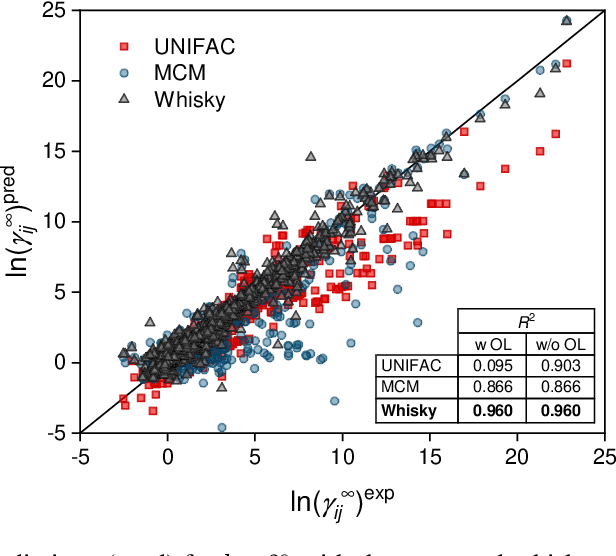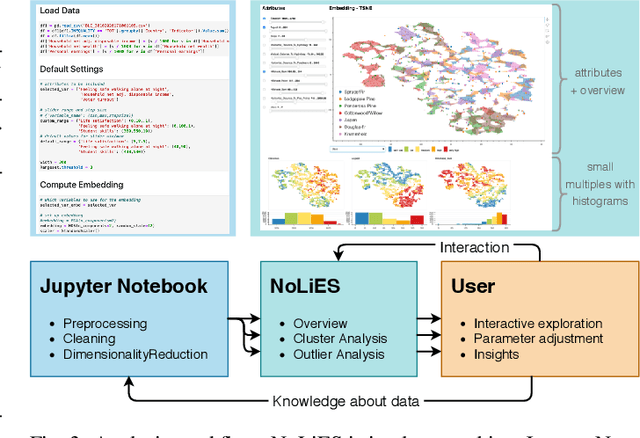Fabian Jirasek
Superstudent intelligence in thermodynamics
Jun 11, 2025Abstract:In this short note, we report and analyze a striking event: OpenAI's large language model o3 has outwitted all students in a university exam on thermodynamics. The thermodynamics exam is a difficult hurdle for most students, where they must show that they have mastered the fundamentals of this important topic. Consequently, the failure rates are very high, A-grades are rare - and they are considered proof of the students' exceptional intellectual abilities. This is because pattern learning does not help in the exam. The problems can only be solved by knowledgeably and creatively combining principles of thermodynamics. We have given our latest thermodynamics exam not only to the students but also to OpenAI's most powerful reasoning model, o3, and have assessed the answers of o3 exactly the same way as those of the students. In zero-shot mode, the model o3 solved all problems correctly, better than all students who took the exam; its overall score was in the range of the best scores we have seen in more than 10,000 similar exams since 1985. This is a turning point: machines now excel in complex tasks, usually taken as proof of human intellectual capabilities. We discuss the consequences this has for the work of engineers and the education of future engineers.
MLPROP -- an open interactive web interface for thermophysical property prediction with machine learning
Apr 08, 2025Abstract:Machine learning (ML) enables the development of powerful methods for predicting thermophysical properties with unprecedented scope and accuracy. However, technical barriers like cumbersome implementation in established workflows hinder their application in practice. With MLPROP, we provide an interactive web interface for directly applying advanced ML methods to predict thermophysical properties without requiring ML expertise, thereby substantially increasing the accessibility of novel models. MLPROP currently includes models for predicting the vapor pressure of pure components (GRAPPA), activity coefficients and vapor-liquid equilibria in binary mixtures (UNIFAC 2.0, mod. UNIFAC 2.0, and HANNA), and a routine to fit NRTL parameters to the model predictions. MLPROP will be continuously updated and extended and is accessible free of charge via https://ml-prop.mv.rptu.de/. MLPROP removes the barrier to learning and experimenting with new ML-based methods for predicting thermophysical properties. The source code of all models is available as open source, which allows integration into existing workflows.
GRAPPA -- A Hybrid Graph Neural Network for Predicting Pure Component Vapor Pressures
Jan 15, 2025Abstract:Although the pure component vapor pressure is one of the most important properties for designing chemical processes, no broadly applicable, sufficiently accurate, and open-source prediction method has been available. To overcome this, we have developed GRAPPA - a hybrid graph neural network for predicting vapor pressures of pure components. GRAPPA enables the prediction of the vapor pressure curve of basically any organic molecule, requiring only the molecular structure as input. The new model consists of three parts: A graph attention network for the message passing step, a pooling function that captures long-range interactions, and a prediction head that yields the component-specific parameters of the Antoine equation, from which the vapor pressure can readily and consistently be calculated for any temperature. We have trained and evaluated GRAPPA on experimental vapor pressure data of almost 25,000 pure components. We found excellent prediction accuracy for unseen components, outperforming state-of-the-art group contribution methods and other machine learning approaches in applicability and accuracy. The trained model and its code are fully disclosed, and GRAPPA is directly applicable via the interactive website ml-prop.mv.rptu.de.
Hierarchical Matrix Completion for the Prediction of Properties of Binary Mixtures
Oct 08, 2024Abstract:Predicting the thermodynamic properties of mixtures is crucial for process design and optimization in chemical engineering. Machine learning (ML) methods are gaining increasing attention in this field, but experimental data for training are often scarce, which hampers their application. In this work, we introduce a novel generic approach for improving data-driven models: inspired by the ancient rule "similia similibus solvuntur", we lump components that behave similarly into chemical classes and model them jointly in the first step of a hierarchical approach. While the information on class affiliations can stem in principle from any source, we demonstrate how classes can reproducibly be defined based on mixture data alone by agglomerative clustering. The information from this clustering step is then used as an informed prior for fitting the individual data. We demonstrate the benefits of this approach by applying it in connection with a matrix completion method (MCM) for predicting isothermal activity coefficients at infinite dilution in binary mixtures. Using clustering leads to significantly improved predictions compared to an MCM without clustering. Furthermore, the chemical classes learned from the clustering give exciting insights into what matters on the molecular level for modeling given mixture properties.
SetPINNs: Set-based Physics-informed Neural Networks
Sep 30, 2024Abstract:Physics-Informed Neural Networks (PINNs) have emerged as a promising method for approximating solutions to partial differential equations (PDEs) using deep learning. However, PINNs, based on multilayer perceptrons (MLP), often employ point-wise predictions, overlooking the implicit dependencies within the physical system such as temporal or spatial dependencies. These dependencies can be captured using more complex network architectures, for example CNNs or Transformers. However, these architectures conventionally do not allow for incorporating physical constraints, as advancements in integrating such constraints within these frameworks are still lacking. Relying on point-wise predictions often results in trivial solutions. To address this limitation, we propose SetPINNs, a novel approach inspired by Finite Elements Methods from the field of Numerical Analysis. SetPINNs allow for incorporating the dependencies inherent in the physical system while at the same time allowing for incorporating the physical constraints. They accurately approximate PDE solutions of a region, thereby modeling the inherent dependencies between multiple neighboring points in that region. Our experiments show that SetPINNs demonstrate superior generalization performance and accuracy across diverse physical systems, showing that they mitigate failure modes and converge faster in comparison to existing approaches. Furthermore, we demonstrate the utility of SetPINNs on two real-world physical systems.
HANNA: Hard-constraint Neural Network for Consistent Activity Coefficient Prediction
Jul 25, 2024Abstract:We present the first hard-constraint neural network for predicting activity coefficients (HANNA), a thermodynamic mixture property that is the basis for many applications in science and engineering. Unlike traditional neural networks, which ignore physical laws and result in inconsistent predictions, our model is designed to strictly adhere to all thermodynamic consistency criteria. By leveraging deep-set neural networks, HANNA maintains symmetry under the permutation of the components. Furthermore, by hard-coding physical constraints in the network architecture, we ensure consistency with the Gibbs-Duhem equation and in modeling the pure components. The model was trained and evaluated on 317,421 data points for activity coefficients in binary mixtures from the Dortmund Data Bank, achieving significantly higher prediction accuracies than the current state-of-the-art model UNIFAC. Moreover, HANNA only requires the SMILES of the components as input, making it applicable to any binary mixture of interest. HANNA is fully open-source and available for free use.
Balancing Molecular Information and Empirical Data in the Prediction of Physico-Chemical Properties
Jun 12, 2024Abstract:Predicting the physico-chemical properties of pure substances and mixtures is a central task in thermodynamics. Established prediction methods range from fully physics-based ab-initio calculations, which are only feasible for very simple systems, over descriptor-based methods that use some information on the molecules to be modeled together with fitted model parameters (e.g., quantitative-structure-property relationship methods or classical group contribution methods), to representation-learning methods, which may, in extreme cases, completely ignore molecular descriptors and extrapolate only from existing data on the property to be modeled (e.g., matrix completion methods). In this work, we propose a general method for combining molecular descriptors with representation learning using the so-called expectation maximization algorithm from the probabilistic machine learning literature, which uses uncertainty estimates to trade off between the two approaches. The proposed hybrid model exploits chemical structure information using graph neural networks, but it automatically detects cases where structure-based predictions are unreliable, in which case it corrects them by representation-learning based predictions that can better specialize to unusual cases. The effectiveness of the proposed method is demonstrated using the prediction of activity coefficients in binary mixtures as an example. The results are compelling, as the method significantly improves predictive accuracy over the current state of the art, showcasing its potential to advance the prediction of physico-chemical properties in general.
Deep Anomaly Detection on Tennessee Eastman Process Data
Mar 10, 2023Abstract:This paper provides the first comprehensive evaluation and analysis of modern (deep-learning) unsupervised anomaly detection methods for chemical process data. We focus on the Tennessee Eastman process dataset, which has been a standard litmus test to benchmark anomaly detection methods for nearly three decades. Our extensive study will facilitate choosing appropriate anomaly detection methods in industrial applications.
Hybridizing Physical and Data-driven Prediction Methods for Physicochemical Properties
Feb 17, 2022


Abstract:We present a generic way to hybridize physical and data-driven methods for predicting physicochemical properties. The approach `distills' the physical method's predictions into a prior model and combines it with sparse experimental data using Bayesian inference. We apply the new approach to predict activity coefficients at infinite dilution and obtain significant improvements compared to the data-driven and physical baselines and established ensemble methods from the machine learning literature.
* Published version
Attribute-based Explanations of Non-Linear Embeddings of High-Dimensional Data
Jul 28, 2021



Abstract:Embeddings of high-dimensional data are widely used to explore data, to verify analysis results, and to communicate information. Their explanation, in particular with respect to the input attributes, is often difficult. With linear projects like PCA the axes can still be annotated meaningfully. With non-linear projections this is no longer possible and alternative strategies such as attribute-based color coding are required. In this paper, we review existing augmentation techniques and discuss their limitations. We present the Non-Linear Embeddings Surveyor (NoLiES) that combines a novel augmentation strategy for projected data (rangesets) with interactive analysis in a small multiples setting. Rangesets use a set-based visualization approach for binned attribute values that enable the user to quickly observe structure and detect outliers. We detail the link between algebraic topology and rangesets and demonstrate the utility of NoLiES in case studies with various challenges (complex attribute value distribution, many attributes, many data points) and a real-world application to understand latent features of matrix completion in thermodynamics.
 Add to Chrome
Add to Chrome Add to Firefox
Add to Firefox Add to Edge
Add to Edge